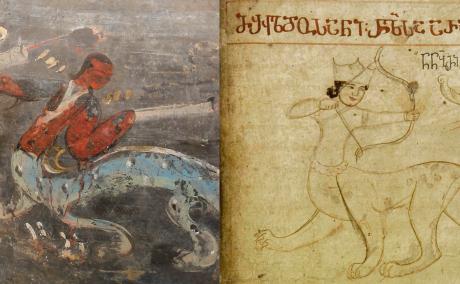538 Search Results
Visualization and Material Cultures of the Heavens in Eurasia and North Africa (4000 BCE–1700 CE)
 No 53
Historian of science Sonja Brentjes reflects on how Sagittarius came to have a feline body and why the tip of its tail is a dragon’s head. Sagittarius, usually a Centaur, suddenly appears in the twelfth century in Eastern Iran with the body of a large cat, probably a tiger. Here, Sagittarius does not shoot his arrow forward but rather aims it at the dragon’s head on the tip of the cat’s tail. More than 1,000 years earlier, a human with a tiger’s body and long tail is depicted on a vase found in a Chinese tomb. The human throws a fire ball towards the tail. In 1188, the same motif appeared in a Georgian translation of a Persian book in the Caucasus Mountains. Could it be that this Chinese motif inspired the feline Sagittarius in Eastern Iran, which then moved westward?
No 53
Historian of science Sonja Brentjes reflects on how Sagittarius came to have a feline body and why the tip of its tail is a dragon’s head. Sagittarius, usually a Centaur, suddenly appears in the twelfth century in Eastern Iran with the body of a large cat, probably a tiger. Here, Sagittarius does not shoot his arrow forward but rather aims it at the dragon’s head on the tip of the cat’s tail. More than 1,000 years earlier, a human with a tiger’s body and long tail is depicted on a vase found in a Chinese tomb. The human throws a fire ball towards the tail. In 1188, the same motif appeared in a Georgian translation of a Persian book in the Caucasus Mountains. Could it be that this Chinese motif inspired the feline Sagittarius in Eastern Iran, which then moved westward?
Visualisierung und materielle Kulturen des Himmels in Eurasien und Nordafrika (4000 v.u.Z.–1700 u.Z.)
 No 53
Die Wissenschaftshistorikerin Sonja Brentjes fragt sich, wie der Schütze zu einem Katzenkörper und zu einem Schwanz mit einem Drachenkopf gekommen ist. Üblicherweise ein Kentaur, erscheint der Schütze plötzlich im zwölften Jahrhundert in Ostiran mit dem Körper einer Großkatze, vermutlich einem Tiger. Er schießt nicht vorwärts, sondern zielt auf den Drachenkopf am Schwanzende der Katze. Mehr als eintausend Jahre früher ist ein Mensch mit einem Tigerkörper und einem langen Schwanz auf einer Vase dargestellt, die in einem chinesischen Grab gefunden worden ist. Die menschliche Figur wirft einen Feuerball gegen das Schwanzende. Könnte es sein, dass dieses chinesische Motiv den felinen Schützen in Ostiran inspiriert hat, der dann nach Westen wanderte? Im Jahre 1188 erscheint dasselbe Motiv in einer grusinischen Übersetzung eines persischen Buches im Kaukasus.
No 53
Die Wissenschaftshistorikerin Sonja Brentjes fragt sich, wie der Schütze zu einem Katzenkörper und zu einem Schwanz mit einem Drachenkopf gekommen ist. Üblicherweise ein Kentaur, erscheint der Schütze plötzlich im zwölften Jahrhundert in Ostiran mit dem Körper einer Großkatze, vermutlich einem Tiger. Er schießt nicht vorwärts, sondern zielt auf den Drachenkopf am Schwanzende der Katze. Mehr als eintausend Jahre früher ist ein Mensch mit einem Tigerkörper und einem langen Schwanz auf einer Vase dargestellt, die in einem chinesischen Grab gefunden worden ist. Die menschliche Figur wirft einen Feuerball gegen das Schwanzende. Könnte es sein, dass dieses chinesische Motiv den felinen Schützen in Ostiran inspiriert hat, der dann nach Westen wanderte? Im Jahre 1188 erscheint dasselbe Motiv in einer grusinischen Übersetzung eines persischen Buches im Kaukasus.
Exhibition: "Leonardo's Intellectual Cosmos" at the Staatsbibliothek zu Berlin, May 11 to June 28, 2021
PRESS RELEASE (PDF)Ausstellung: „Leonardos intellektueller Kosmos“ in der Staatsbibliothek zu Berlin, 11. Mai bis 28. Juni 2021
PRESS RELEASE (PDF)International Max Planck Research School "Knowledge and Its Resources" featured in Berliner Zeitung
Go to Article (German, Paywall)Internationale Max Planck Research School „Knowledge and Its Resources“ in Berliner Zeitung vorgestellt
Zum Artikel (Deutsch, Paywall)Visualization and Material Culture of the Heavens Database: An Image Database as a Research Tool
The database is the core result produced by the VoH Working Group and the foundation of further digital output. It contains images depicting the diver
Dept3_VoHWG_Screenshot.jpeg
Please contact rbrentjes@mpiwg-berlin.mpg.de if you are interested in sharing material with us or would like access to our collections.
Presentation | Mar 30, 2023 | 15:00 to 17:00
The Pyramid of Knowledge: Tracing the Roots of the Intellectual Background of the Florentine "Accademia Del Cimento"
MoreImage Database: Visualization and Material Cultures of the Heavens
The protected image database developed in the framework of the Working Group “Visualization and Material Cultures of the Heavens” reflects
Dept3_DB_VOH_Kudurru.jpg, Project_DeptSchaefer_Brentjes.jpeg
Please contact rbrentjes@mpiwg-berlin.mpg.de if you are interested in sharing material with us or would like access to our collections.
Database, Image Database: Visualization and Material Cultures of the Heavens, Events, Visualizations of the Heavens—The Database as a Research Tool
Lecture Series 2022, Visualizations of the Heavens
Lorraine Daston interviewed by Süddeutsche Zeitung on visualization in science
Go To Article (German, Paywall)